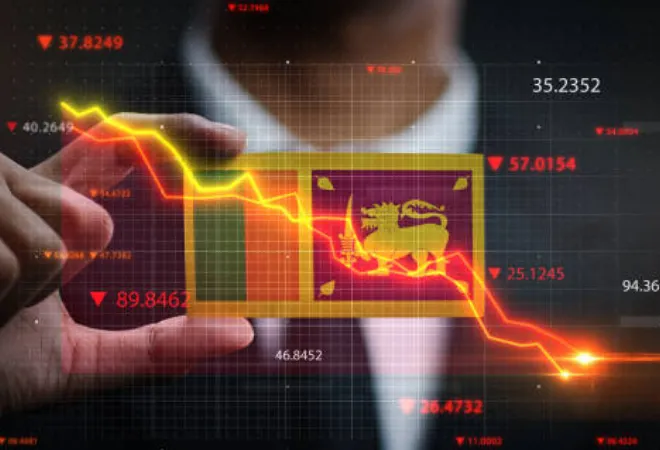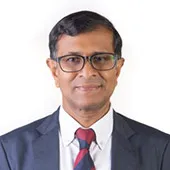
Is Sri Lanka moving on from the unprecedented economic crisis in 2022 and how should India-Sri Lanka relations adapt to this are a few pressing questions facing New Delhi. Many had begun to write Sri Lanka off as
a basket case of economic development tragically gone wrong, highlighting
Sri Lanka’s excessive borrowing for Chinese Belt and Road Initiative projects. There is little doubt that Sri Lanka’s economic crisis offers
cautionary lessons for others in the developing world. An acute balance of payments crisis forced Sri Lanka to preemptively default on foreign debt of over
US$50 billion in April 2022, triggering a crippling economic contraction with spiralling inflation. Sri Lanka’s GDP fell by
7.8 percent in 2022, with year-on-year inflation rising to
69.8 percent in September 2022 (measured by the Colombo Consumer Price Index) and a reversal of previous gains in poverty reduction. Mass protests by ordinary Sri Lankans against
family-dominated governance and economic mismanagement also resulted in the
resignation of the government of President Gotabaya Rajapaksa and his brother Mahinda Rajapaksa.
The good news now is that the Sri Lankan economy is showing signs of stabilising. A return to growth in Sri Lanka is expected next year—
the latest International Monetary Fund (IMF) forecast released in April 2023 suggests a less severe economic contraction of -3.1 percent in 2023 and growth of 1.5 percent in 2024. Year-on-year inflation fell to
35.3 percent in April 2023. But negative growth in 2022-2023 means job losses across the economy, a
doubling of income poverty to 25 percent of the population (at US$3.65 per capita, 2017 PPP) and child malnutrition as many families are switching to less nutritious diets.
An acute balance of payments crisis forced Sri Lanka to preemptively default on foreign debt of over US$50 billion in April 2022, triggering a crippling economic contraction with spiralling inflation.
The revised economic outlook for Sri Lanka is underpinned by calming of the turbulent political situation, which is allowing ordinary Sri Lankans to live their lives; decisive economic measures by the new Sri Lankan government under President Ranil Wickremasinghe; and timely Indian aid. From late July 2022 onwards, the Wickremasinghe government began implementing measures to stabilise the economy, intensified talks on an IMF Programme, and sought assurances from Sri Lanka’s bilateral creditors on debt restructuring. Concrete economic stabilisation measures included significantly tightening monetary policy to control spiralling inflation, raising taxes, removing fuel and electricity subsidies, and a privatisation programme for commercial state-owned enterprises (SOEs) including Sri Lankan Airlines, Sri Lankan Telecom, and Sri Lanka Insurance.
Responding to crisis-hit Sri Lanka’s urgent request for external financing pending an IMF Programme, India mobilised the largest bilateral aid package in its history. This aid was motivated by the unfolding humanitarian crisis affecting the Sri Lankan people, worries about a flood of refugees across the Palk Strait, and
political pressure from South India. Indian aid of about
US$4 billion during the first half of 2022 flowed to Sri Lanka through credit lines, loans, and grants. India’s aid to Sri Lanka in 2022 far exceeds bilateral aid to Sri Lanka by other development partners and has
cemented its reputation as a key emerging donor. India also undertook quiet diplomacy for Sri Lanka’s IMF Programme and just extended a
US$1billion credit line to Sri Lanka until March 2024. As early as July 2020, the Reserve Bank of India had agreed to a currency swap arrangement with the Central Bank of Sri Lanka for short-term financing of US$400 million to mitigate the effects of the COVID-19 pandemic.
The Wickremasinghe government began implementing measures to stabilise the economy, intensified talks on an IMF Programme, and sought assurances from Sri Lanka’s bilateral creditors on debt restructuring.
In March 2023,
the IMF Board approved a long-delayed IMF Programme of US$2.9 billion over 48 months for Sri Lanka after receiving assurances that financing or debt relief provided by all bilateral creditors would be consistent with restoring debt sustainability under the Programme. An IMF bailout after defaulting inevitably has
geopolitical repercussions. Talks with China—a holder of as much as
8.5 percent of Sri Lanka’s public debt (June 2022)—were lengthy due to China’s tough zero COVID-19 restrictions and Chinese demands that its debt be treated differently to other bilaterals. After high-level discussions between President Wickremasinghe and senior Chinese officials, China eventually gave creditor assurances to IMF’s satisfaction.
The
17th and toughest IMF Programme in Sri Lanka’s history is important to tackle the economic crisis. It seeks to restore fiscal and debt sustainability by raising taxes and improving tax administration, improving public expenditure management and anti-corruption measures, better-targeting poverty reduction programmes, creating an independent central bank, and recapitalising the banks. The programme will unlock external financing with US$333 million immediately disbursed followed by Asian Development Bank and World Bank financing. Some risks, however, could affect IMF Programme implementation including a difficult debt restructuring process ahead, a lack of political consensus among political parties on the IMF Programme and a sharp global economic slowdown.
Nonetheless, the changing outlook for Sri Lanka makes it opportune for India-Sri Lanka ties to shift from an aid relationship to
deepening bilateral trade and foreign direct investment (FDI) flows. The conglomerate Adani Group recently committed to
investing US$1,142 billion in wind power renewable energy plants in the Mannar basin and the West Container Terminal in Colombo Port. Adani’s huge projects are equivalent to nearly 67 percent of all Indian FDI into Sri Lanka between 2005-2019. A miles-long transmission line running through the Indian Ocean to promote bilateral power trade is also being discussed. It was reported that the conglomerate Tata Group, which acquired Air India in January 2022, was currently in talks to buy Sri Lankan Airlines. One hopes that these Indian infrastructure projects will be transformative for Sri Lanka by bringing capital as well as transferring skills and technology. Confidence built through these investments could encourage more Indian FDI in Sri Lanka in agro-processing, textiles and light manufacturing, and information technology services sectors.
India and Sri Lanka should actively promote bilateral FDI flows by better marketing to investors, liberalising FDI entry regulations and cutting the red tape from hampering investors through digitisation.
Similarly, globalising Sri Lankan firms should invest in companies in South Indian states such as Brandix in textiles, Dilmah in tea and tourism, and John Keels Holdings in food processing and tourism. India and Sri Lanka should actively promote bilateral FDI flows by better marketing to investors, liberalising FDI entry regulations and cutting the red tape from hampering investors through digitisation. Early resumption of talks on a comprehensive India-Sri Lankan trade deal to promote regional rules-based trade and FDI would be the icing on the cake. The goal should be to achieve a high-standard trade deal to facilitate deep integration in supply chains and services by adopting the so-called 21
st-century trade rules.
One year on, Sri Lanka seems to be transitioning from an economic crisis to a recovery pathway. With political will to implement the IMF Programme, Sri Lanka could see some economic normalcy in a few years. India-Sri Lanka ties should shift from an aid relationship to deepening trade and investment flows for mutual benefit. A growing Sri Lanka would be a major win for Prime Minister Narendra Modi’s Neighbourhood-First policy and enable India to steal a march over China as an emerging donor during its G20 presidency.
Ganeshan Wignaraja is the Professorial Fellow in Economics and Trade at Gateway House: Indian Council on Global Relations in Mumbai and a Senior Research Associate at ODI in London
The views expressed above belong to the author(s). ORF research and analyses now available on Telegram! Click here to access our curated content — blogs, longforms and interviews.



 Is Sri Lanka moving on from the unprecedented economic crisis in 2022 and how should India-Sri Lanka relations adapt to this are a few pressing questions facing New Delhi. Many had begun to write Sri Lanka off as
Is Sri Lanka moving on from the unprecedented economic crisis in 2022 and how should India-Sri Lanka relations adapt to this are a few pressing questions facing New Delhi. Many had begun to write Sri Lanka off as  PREV
PREV


